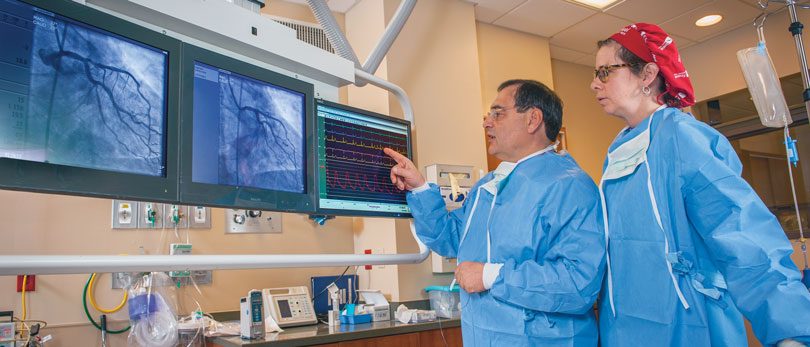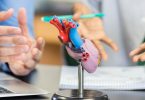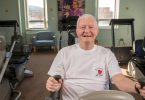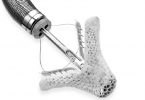Despite significant advances in the diagnosis and treatment of heart disease, approximately 600,000 Americans die each year from a heart attack—often due to delayed care.
Time is frequently lost because the patient does not know the signs of a heart attack and when to call 911. The American Heart Association estimates that half of all people suffering a heart attack wait more than two hours before seeking help.
Because delayed treatment leads to damaged heart muscle, those hours can mean the difference between death or other serious consequences and a full recovery. Even when patients heed the early warning signs of a heart attack, diagnosis may be delayed when the patient is first examined. Sometimes the patient is not in obvious distress or early tests deliver false negative results for heart attack. More than 35,000 heart attack patients annually initially present with inconclusive or false-negative test results.
The Chest Pain Center at UHS Wilson Medical Center specializes in comprehensively evaluating, diagnosing and treating this subset of chest pain patients—those with borderline symptoms and inconclusive test results who may be on the verge of having full-blown heart attacks. The Chest Pain Center is the region’s only such facility accredited by the Society of Cardiovascular Patient Care.
KNOW THE SIGNS BY HEART
Time is of the essence when suffering a heart attack. To protect heart muscle, preserve heart function and save your life, fast medical intervention is crucial. For these reasons, it’s imperative that you know the symptoms of a heart attack. If you experience these signs, call 911 immediately.
- Chest discomfort: This can be extreme pain and/or pressure in the center of the chest that lasts for several minutes or comes and goes.
- Upper body discomfort: Symptoms can include pain or discomfort in one or both arms, the back, shoulders, neck, jaw or stomach.
- Shortness of breath: This sign may or may not include chest discomfort.
- Additional signs: Symptoms vary, and are especially different in men and women.
Less-obvious symptoms may include sudden and unexplained sweating, lightheadedness, nausea and/or vomiting or extreme fatigue.
THE RIGHT PLACE AT THE RIGHT TIME
When a patient at the UHS Wilson Medical Center Emergency Department is diagnosed with inconclusive chest pain, he or she is typically transferred to the Chest Pain Center in the hospital. There, a highly trained team of cardiac specialists continues to observe, evaluate and treat him or her. “These patients appear to have a low level of risk for heart attack. But appearances can be deceiving and the chest pain is real,” says Stephen Gomez, MD, UHS director of Emergency Medicine. “We’re not willing to take chances. So, the safer solution is to transfer these low-risk patients to our Chest Pain Center for focused observation.”
Combating risk of misdiagnosis due to false negative tests tops the list of Chest Pain Center benefits, according to Nicholas J. Stamato, MD, FACC, director of cardiology at UHS Wilson Medical Center. “This system saves lives. For many patients who are about to have a heart attack, their first EKG and blood test come back normal,” Dr. Stamato explains. “Before the center, these patients were often sent home, where they later suffered a heart attack. Now, when we suspect anything abnormal, these patients move to our Chest Pain Center. They’re released once we’re sure the pain is not heart-related. Or, if something should happen, they’re in the right place for immediate treatment—during the critical early stages of their heart attack, when treatment is most effective.”
THE GOLD STANDARD
To earn accreditation from the Society of Cardiovascular Patient Care, the Chest Pain Center went through a rigorous, multidisciplinary process. The center was judged on eight key elements, which collectively demonstrate the hospital’s commitment to fast, efficient and expert care of patients experiencing chest pain. “It means that our physicians and staff know the latest protocols for diagnosing and treating cardiac patients, resulting in the highest possible quality of care,” explains Kim Pilarchik, director of Cardiac Services. “And that includes caring for patients with symptoms that don’t point to an obvious heart attack.”
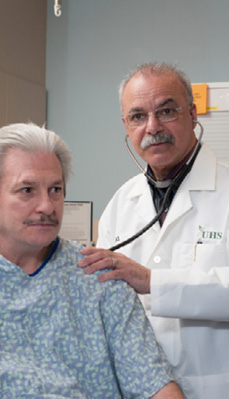
Stephen Gomez, MD, explains that while the ED is the first line of defense for patients who may be having a heart attack, the Chest Pain Center is the next stop for patients with inconclusive results
The accreditation, explains Dr. Gomez, strengthens the center’s ability to meet the highest possible level of care. “To maintain accreditation, we must continually assess our Chest Pain Center program,” he says. “Heart care is a dynamic process; it’s not static. And to stay on the cutting edge, we have to grow with the knowledge and technology available.”
An additional benefit of accreditation, Ms. Pilarchik adds, is increased coordination between the Chest Pain Center and local emergency medical system (EMS) personnel. “This has always been a strong partnership, because every minute counts for a heart patient,” she says. “But to achieve this level of accreditation, we had to create an even stronger relationship.”
If extended observation and testing in the Chest Pain Center does eventually prove that a patient is about to suffer a heart attack, says Dr. Stamato, “The patient is in a place that is dedicated to treating heart attacks. Very rapidly, these patients begin the right treatment. It all happens quickly—whatever they need.”
TAKE HEART
If you suspect you may be having a heart attack, call 911 immediately. Evaluation can begin in the ambulance. To learn more about the benefits of Chest Pain Center accreditation, read the web exclusive.

